Key Points:
- Iowa is home to 28 species of snake, with only four being venomous.
- Common garter snakes make phenomenal pets. They tend to be on the smaller side, growing to be 3 or 4 feet, are peaceful creatures, and are active during the day rather than at night, so they could be a perfect first pet.
- The copperhead is responsible for more snake bites in Iowa than any other snake.
A state famous for its prairies and corn fields, it’s easy to believe that Iowa makes a good home for snakes. Indeed, Iowa is home to 28 species of snake. Furthermore, the vast majority of these snakes, including the most common ones, are nonvenomous and safe for humans to handle, which means that they may make good pets!
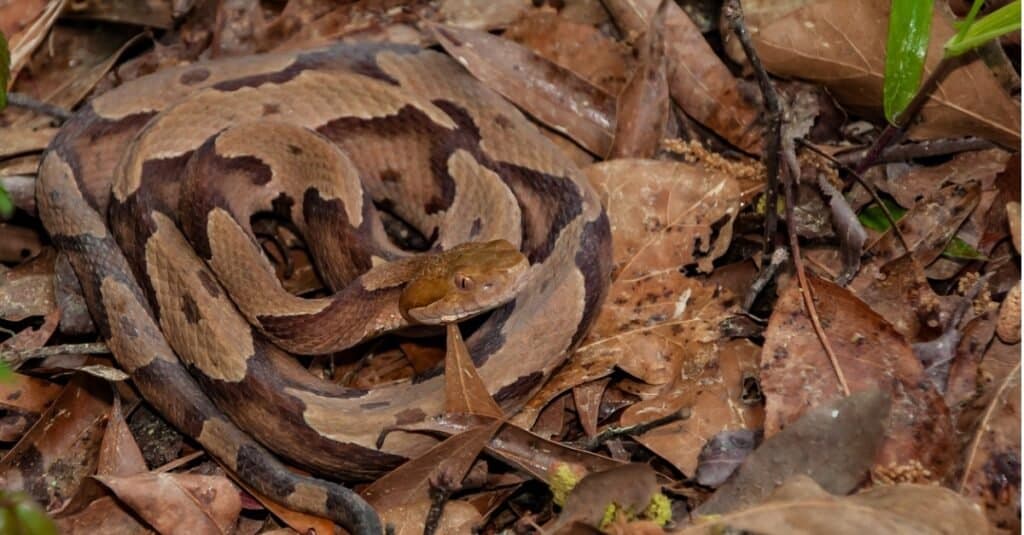
Copperheads are easily hidden on the ground because of their color.
©iStock.com/JasonOndreicka
However, even though Iowa is only home to four species of a venomous snake, each is capable of injuring or killing someone with a well-timed bite. Does this mean that the Iowa outdoors is impossible to enjoy? Of course not! Luckily, these venomous snakes are not only rare but often quite shy as well. With this list, we hope to educate readers about the many wonderful snakes that live in the Hawkeye State, as well as how to identify and protect themselves from the more dangerous ones. We hope snake lovers and outdoor adventurers alike will enjoy this list!
Snakes in Iowa
Let’s first dive into some of the most common snakes you’ll find across Iowa. Each of these is non-venomous.
Common Garter Snake
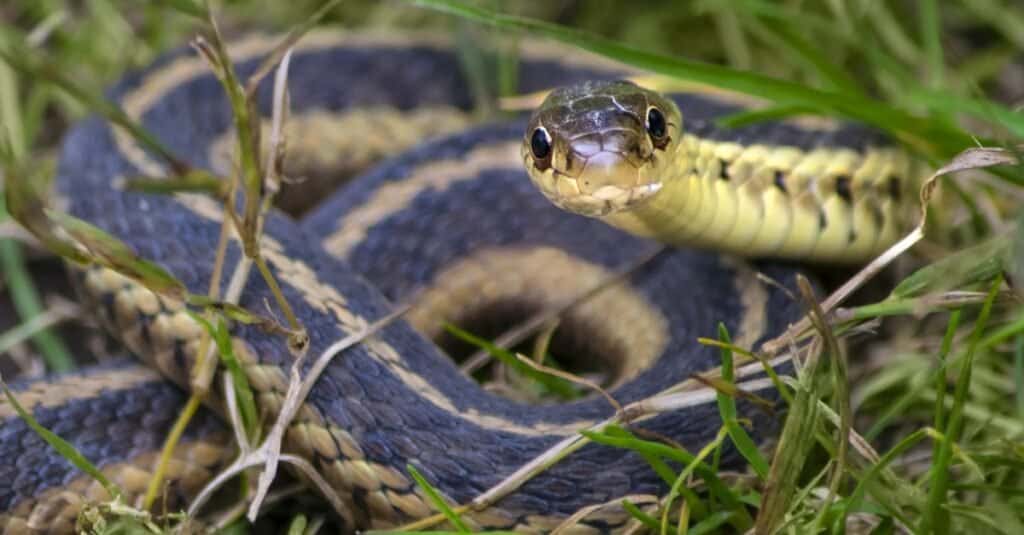
Common garter snakes are one of the most common snakes in Iowa.
©K Quinn Ferris/Shutterstock.com
With its iconic dark body and yellow stripe, this species of a garter snake is the most common throughout Iowa, as well as many other states. These snakes are so abundant that they are the only species of snake you are allowed to capture or kill in the state. However, there is almost never a need for that, since garters are completely harmless to people. The worst thing they can do is unleash a smelly musk to distract and escape from potential predators.
On the contrary, garter snakes make phenomenal pets. They tend to be on the smaller side, growing to be 3 or 4 feet, though some have been known to reach 5 feet. They are peaceful creatures, and they are active during the day rather than at night, so they could be a perfect first pet for someone interested in snakes. The only disclaimer is their diet; they enjoy small things such as fish, worms, and amphibians. If you don’t mind the idea of storing and handling these things, the common garter snake could be a terrific addition to your family.
Western Fox Snake
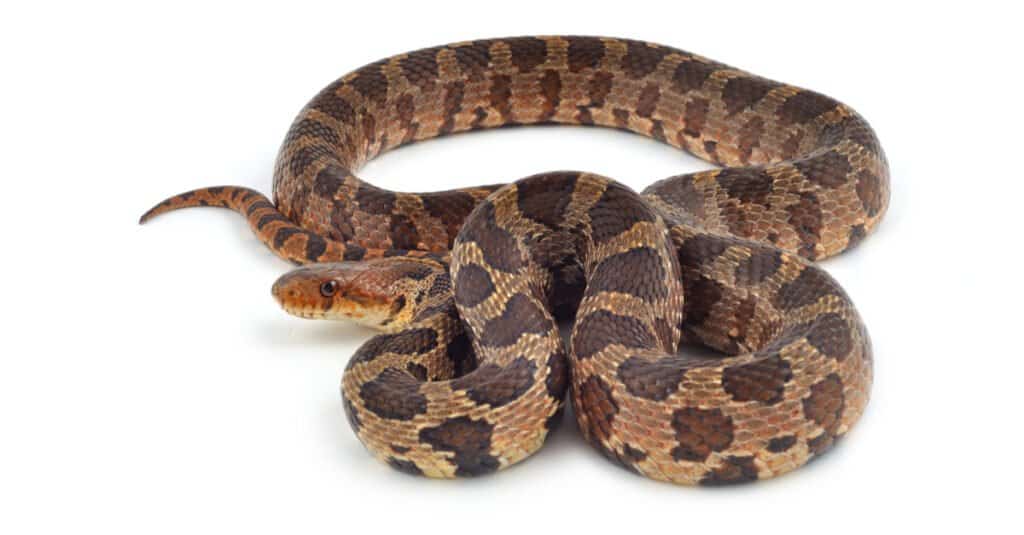
Western fox snakes are found across the majority of Iowa (not in some northern counties).
©James DeBoer/Shutterstock.com
The western fox snake is named for the very smelly musk it emits that smells similar to that of a fox. Despite being a common sight in Iowa, the western fox snake is endangered in some states. Perhaps this is due to their similarities to the venomous copperhead. Both snakes have body colors ranging from light brown to tan, leading to some understandable confusion. If you need to differentiate the two, just look at their heads. The copperhead will have a wide, triangular head with eyes like a cat. However, the fox snake has a narrower head and round pupils. That being said, if you’re unsure, it’s safer to assume the worst and steer clear of it.
Unlike copperheads, and like garter snakes, western fox snakes tend to make good pets. Despite potentially growing to a length of 5 feet, they are still docile animals that have no reason or means to hurt humans. In the wild, they can be found in a variety of environments, including gardens, fields, and wetlands, and they are capable of climbing and swimming. Their favorite prey includes small birds, amphibians, and eggs.
Brown Snake
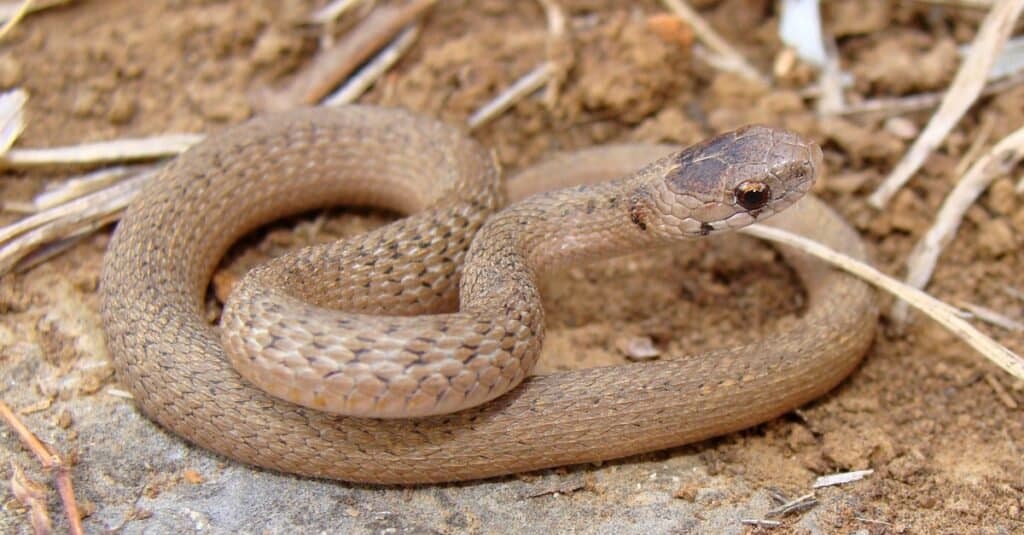
Brown snakes in Iowa are among the shortest snake species in the state.
©Matt Jeppson/Shutterstock.com
The smallest snake on this list at 13 inches, the brown snake poses no threat to humans. Luckily for the snake, humans pose little threat to it either, which is why the snake has been able to spread to most areas of Iowa. They are a common sight in urban areas such as parks, ponds, and yards, as well as more wild areas like prairies and wetlands. Though usually brown, some will be colored gray, and most have a row or two of dark spots on their backs.
The brown snake is a bit bolder than some other snakes, meaning that they make great pets, though it is illegal to capture them in the wild. They are also easy to feed, preferring a diet of worms and the occasional snail. If one wants a “friendlier” snake, then the brown snake’s bravery and small size make it a relatively gentle companion.
Venomous Snakes in Iowa
There are four different venomous snakes in Iowa. The most common is the timber rattlesnake. In western Iowa, you’ll want to be more on the lookout for prairie rattlesnakes, which are more common along the Missouri River. Copperheads are listed as a venomous snake in Iowa, but their range only slightly extends into Missouri in the southernmost counties along the Mississippi River.
Timber Rattlesnake
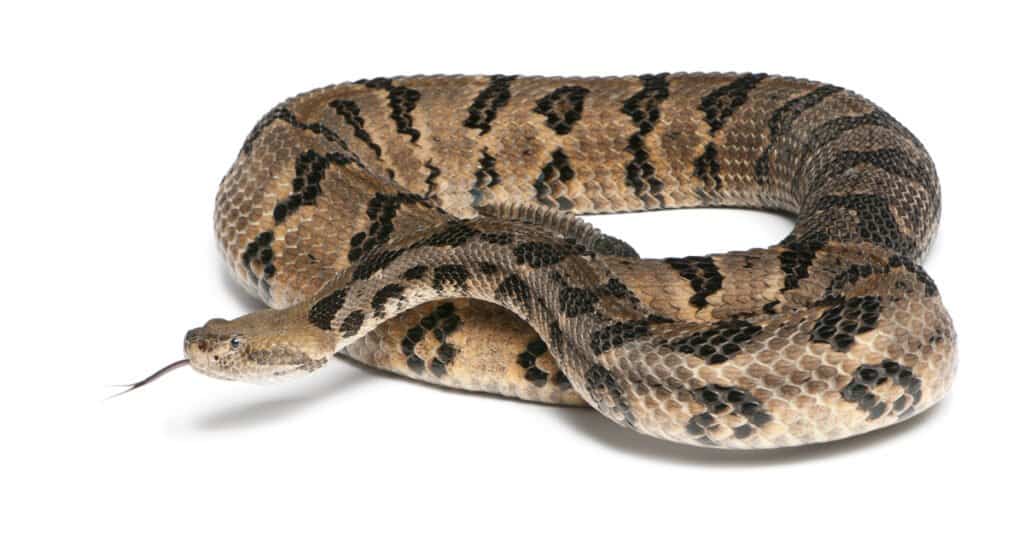
Timber rattlesnakes
are found mostly in the eastern half of Iowa.
©Eric Isselee/Shutterstock.com
The most populous venomous snake in Iowa, the timber rattlesnake is a common sight throughout the United States. They tend to make their homes in the forest of eastern and southern Iowa, though females may migrate to rockier, cooler areas while pregnant. Even though they are more common than other snakes, they still prefer to avoid people (and other predators) altogether, so they will stick to trees, undergrowth, and rocky crevices to avoid detection.
Timber rattlers are easy to identify by their yellow-brown or gray bodies, dark blotches, triangular heads, slit-shaped pupils, and light-colored rattles on black tails. They also have a colored stripe running down their backs, similar to a garter snake. Timbers are also the largest venomous snakes in Iowa, reaching an impressive 6 feet in length. There are reports of some living to be 30 years old in captivity, but in the wild, it’s more common for them to reach an age of about 10 years. If you are ever traversing the forested wilds of Iowa and hear their iconic rattle, it means you may have wandered into their territory by mistake. Listen for the rattle, then go the opposite way; you do not want to be bitten by any of Iowa’s rattlesnakes, least of all the timber.
Massasauga Rattlesnake
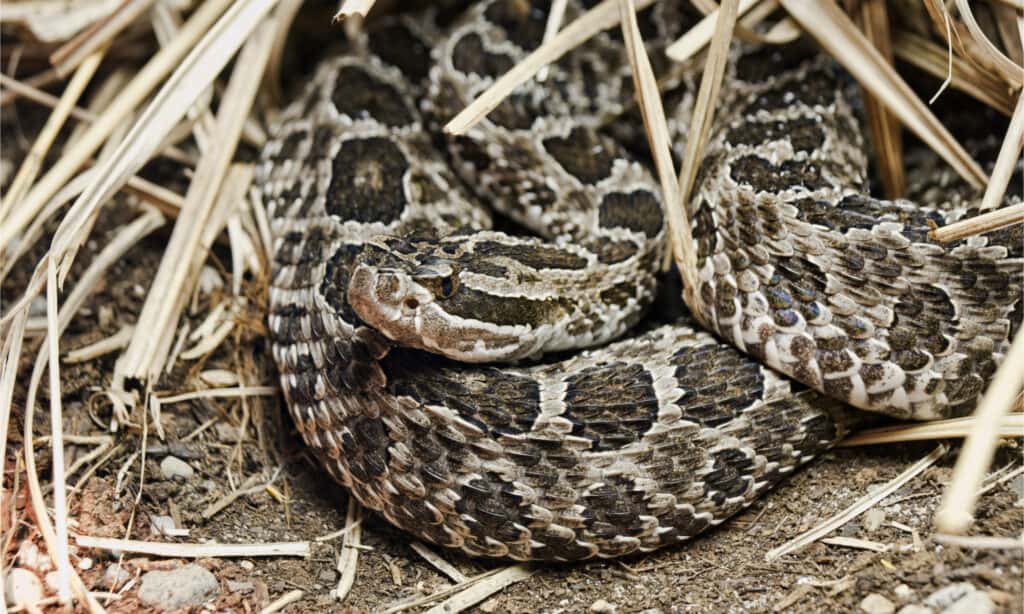
There are two types of massasauga snakes in Iowa.
©DnDavis/Shutterstock.com
In Iowa, there are two types of massasauga you may encounter: the western massasauga and the eastern massasauga. The western massasauga sticks to the rocky areas of southwestern Iowa, while the eastern massasauga prefers the marshes. Both snakes are quite rare in the wild. This is due to not only their shy nature but human-induced habitat loss as well. They typically both have gray bodies, dark blotches, triangular heads, and slit-shaped pupils, though some eastern massasaugas may be colored brown. The western massasauga is the larger of the two at 39 inches, while the eastern massasauga can reach 30 inches. Though they prefer to eat small mammals, they will also take small amphibians and lizards if they have the chance.
As mentioned earlier, the massasauga is quite shy and would prefer to scare off aggressors with its rattle. In fact, most massasaugas will turn tail and flee before they try to attack. However, if backed into a corner, they are capable of delivering a deadly bite of venom, which is just as deadly as those of other rattlesnakes. That being said, both types of massasauga are becoming increasingly rare encounters for hikers across Iowa, and as long as they don’t openly antagonize them, they have little to fear.
Prairie Rattlesnake
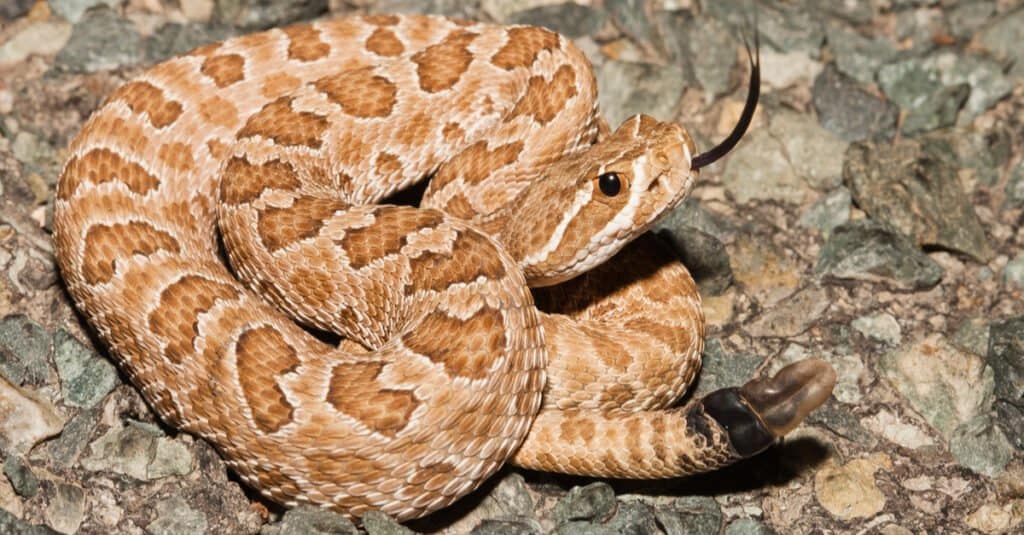
Prairie rattlesnakes are common across western Iowa.
©Nathan A Shepard/Shutterstock.com
True to its name, the prairie rattlesnake makes its home in the grasslands of western Iowa, particularly along the Missouri River. Here, it can catch plenty of its preferred prey of rabbits, prairie dogs, and other small mammals. They can reach the age of 20 years in captivity and live for three or four years, though some have been known to reach five years. Some distinguishing features are brown spots across its body and two lines on each side of its head. They also come in a variety of colors, including green, brown, and tan. They often grow to be three feet or longer, with the biggest ever recorded being 4.97 feet long.
The prairie rattlesnake certainly isn’t the most common snake in Iowa. On top of having a habitat limited to the prairies of Loess Hills and surrounding areas, they are also an endangered species. If you are traversing this area, keep an ear open for rattles. Unless you happen to be a small rodent, they typically won’t bother you unless you bother them.
Copperhead
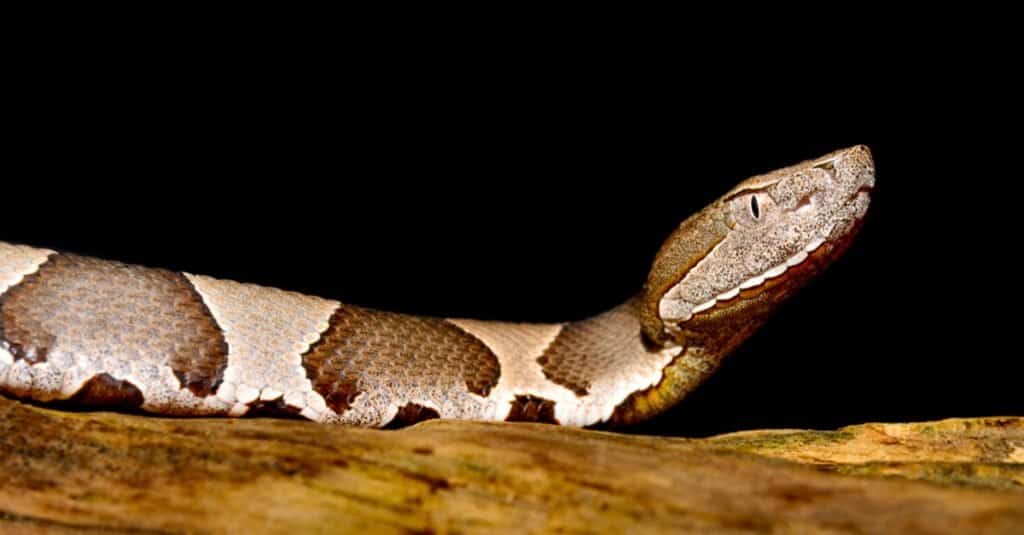
Coppherheads are common venomous snakes throughout the United States.
©Jeff W. Jarrett/Shutterstock.com
A common venomous snake throughout the United States, the copperhead is considered an endangered species in Iowa, but this is mostly because the state lies just barely within its range. If you encounter a copperhead in Iowa, it will likely be in the southeastern corner of the state. However, it would still be foolish to underestimate them, since this species has bitten more people throughout this country’s history than any other venomous snake. They can be found in several types of areas, including urban locations.
Due to their tan or copper coloring, they can sometimes blend into their environments, so keep an eye out for their dark blotches, triangular heads (unlike the fox snake’s narrower head), and a length of 2 to 3 feet. If you see one, it’s probably hunting small mammals or amphibians, so you probably shouldn’t worry. As long as you don’t deliberately provoke them, you should be fine.
Other Snakes Found in Iowa
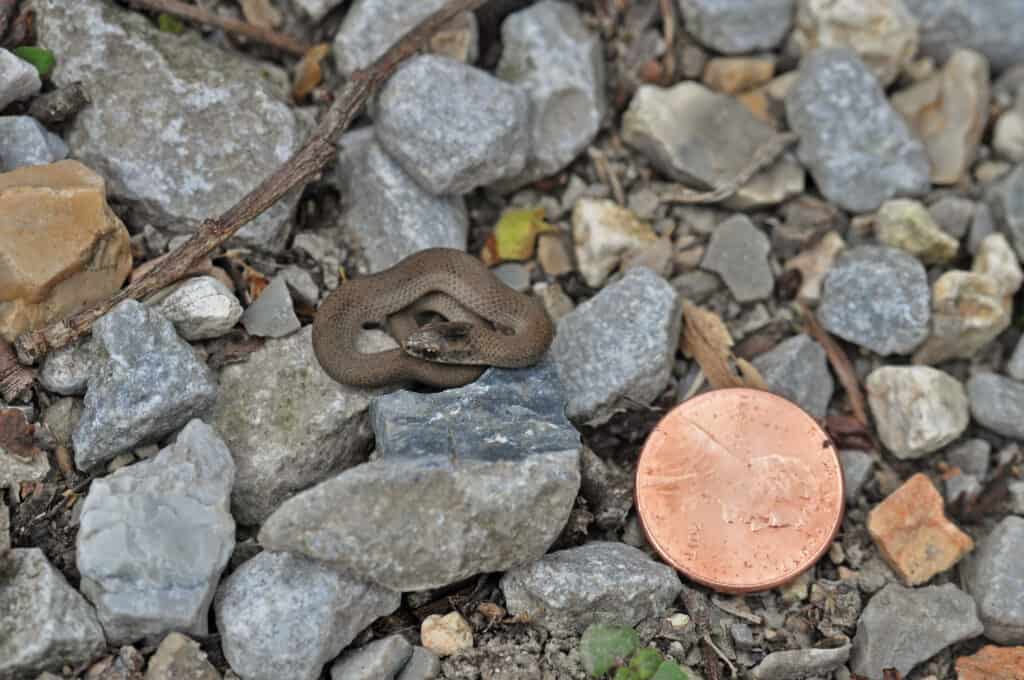
Smooth earth snakes are part of Iowa’s insect-control crew and keep the population of snails, slugs, and
earthworms
under control.
©Mike Wilhelm/Shutterstock.com
Smooth earth snakes only measure about 7-9 inches long and are often mistaken for worms. They are brown to fawn colored with a lighter colored belly. These non-venomous snakes are reclusive and difficult to observe and found under rocks and logs, in loose soil and compost, and under debris in and around gardens. Being so small and with few defenses, smooth earth snakes tend to choose flight over fight when confronted. Gentleness is needed when handling these delicate little snakes as they are much more fragile than most reptiles. You will find smooth earth snakes in the same places you find earthworms and slugs: in the dirt and under rocks. Fossorial snakes like these spend most of their time underground sheltering from the sun or hunting. This docile little snake isn’t seen much during the day but is often seen hunting at night when snails, slugs, and earthworms are active.
What State Has the Most Snake Attacks?
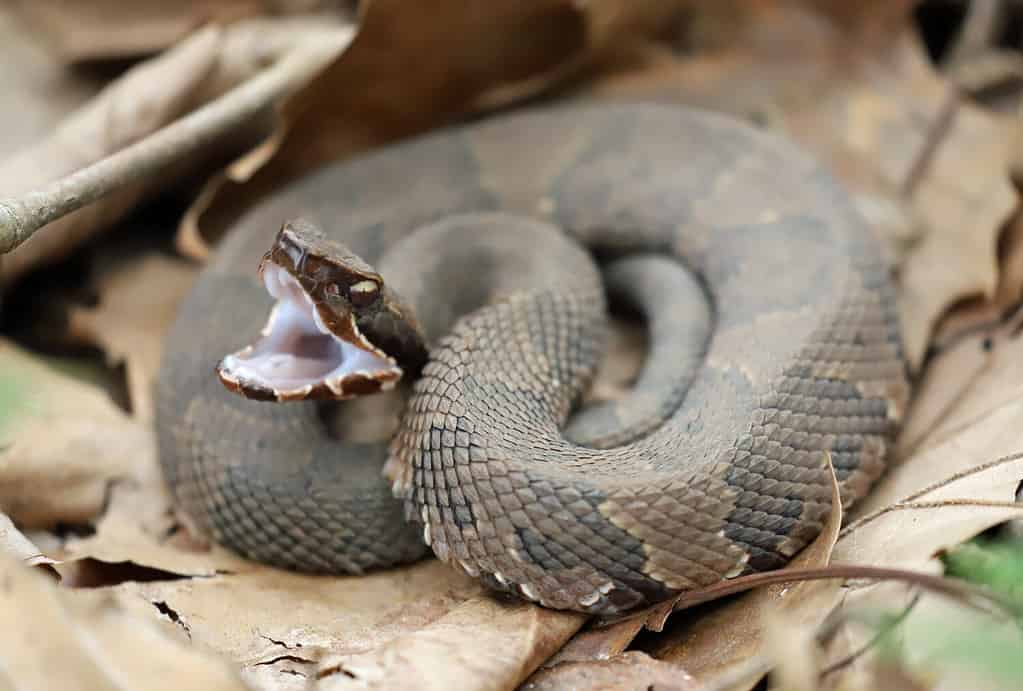
Cottonmouth snakes are one of the venomous species responsible for snake bites in North Carolina.
©KF2017/Shutterstock.com
In Iowa, there are not many snake bites reported per year–in fact, exact information on it is hard to find. In one report on venomous snakes in Iowa, which is dated (1960), there was only one known reported bite by a venomous copperhead snake. But what state ranks the highest in snake bites? That would be North Carolina. This southeastern state’s bite rate is 157.8 bites per million population per year. How does that average out? Well, the population as of 2021 was a little over 10 million (10.55 to be exact). If we were to just figure it off of 10 million, that would mean that there are roughly 1,580 reported snake bites per year.
The top 6 states for reported snake bites are as follows:
- North Carolina–157.8 bites per million
- West Virginia–105.3 bites per million
- Arkansas–92.9 bites per million
- Oklahoma–61 bites per million
- Virginia–48.7 bites per million
- Texas–44.2 bites per million
In North Carolina, there are 6 different kinds of venomous snakes: copperhead, cottonmouth, timber rattlesnake, pigmy rattlesnake, eastern diamondback rattlesnake, and eastern coral snake. In 2019, 92 people were bitten by venomous snakes in that state.
Summary of Snakes in Iowa
Here’s a recap of the snakes present in Iowa that we took a look at:
| Number | Snake | Type | Length |
|---|---|---|---|
| 1 | Common Garter Snake | Non-venomous | 3-4 feet, some have reached 5 feet |
| 2 | Western Fox Snake | Non-venomous | Up to 5 feet |
| 3 | Brown Snake | Non-venomous | 13 inches |
| 4 | Timber Rattlesnake | Venomous | 6 feet |
| 5 | Massasauga Rattlesnake | Venomous | Western massasauga: 39 inches; eastern massasauga: 30 inches |
| 6 | Prairie Rattlesnake | Venomous | 3 feet |
| 7 | Copperhead | Venomous | 2-3 feet |
| 8 | Smooth Earth Snake | Non-venomous | 7-9 inches |
A Complete List of 28 Snakes in Iowa
Below you’ll find a complete list of the 28 snakes found in Iowa:
- Western Massasauga
- Eastern Massasauga
- Timber Rattlesnake
- Prairie Rattlesnake
- Eastern Copperhead
- Lined Snake
- Smooth Earth Snake
- Western Ribbon Snake
- Plains Garter Snake
- Common Garter Snake
- Brown Snake
- Redbelly Snake
- Graham’s Crayfish Snake
- Western Rat Snake
- Gopher Snake
- Western Fox Snake
- Plain belly Water Snake
- Sooth Green Snake
- Northern Water Snake
- Diamondback Water Snake
- Eastern Hognosed Snake
- Eastern Milk Snake
- Prairie Kingsnake
- Speckled Kingsnake
- Plains Hognose Snake
- Western Worm Snake
- North American Racer
- Ringneck Snake.
In Conclusion
Hopefully, you’ve picked up on something quite notable about Iowa’s snakes: the venomous snakes are actually quite shy! Even though they are predators and make up a large chunk of Iowa’s venomous species, their prey consists of small animals such as mice and birds. They have no interest in hunting humans, and they only use venom on us as a means of self-defense. As long as people respect their privacy and homes, they should have no trouble enjoying the wilds of Iowa. Plus, there are many more nonvenomous snakes that we haven’t even covered that call Iowa home. So feel free to go snake-watching; just keep a safe distance!
The photo featured at the top of this post is © Joe McDonald/Shutterstock.com
Discover the "Monster" Snake 5X Bigger than an Anaconda
Every day A-Z Animals sends out some of the most incredible facts in the world from our free newsletter. Want to discover the 10 most beautiful snakes in the world, a "snake island" where you're never more than 3 feet from danger, or a "monster" snake 5X larger than an anaconda? Then sign up right now and you'll start receiving our daily newsletter absolutely free.
Thank you for reading! Have some feedback for us? Contact the AZ Animals editorial team.







